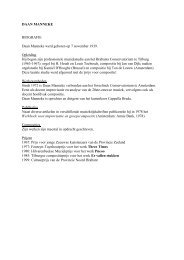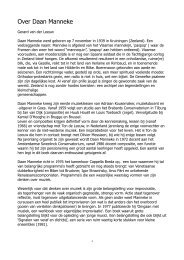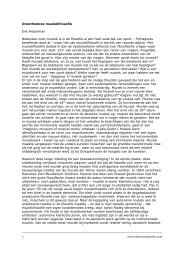Anton Webern and the influence of Heinrich Isaac
Anton Webern and the influence of Heinrich Isaac
Anton Webern and the influence of Heinrich Isaac
Create successful ePaper yourself
Turn your PDF publications into a flip-book with our unique Google optimized e-Paper software.
Ano<strong>the</strong>r crab canon occurs in <strong>the</strong> Versus <strong>of</strong> Office XX <strong>of</strong> Choralis<br />
Constantinus (p.153, Example 9), this time between <strong>the</strong> altus <strong>and</strong> <strong>the</strong> tenor. Once<br />
more it reveals a symmetrical construction (see Example 10). The symmetry is even<br />
more clearly evident in this example as it is not obscured by simultaneous intricate<br />
workings in <strong>the</strong> bassus <strong>and</strong> discantus parts. The symmetry between <strong>the</strong> two parts is<br />
only unbalanced by <strong>Isaac</strong>’s (unsurprising) decision to sustain <strong>the</strong> altus into <strong>the</strong> final<br />
bar, but despite this, <strong>the</strong> possibilities it must have suggested to <strong>Webern</strong> are clearly<br />
evident.<br />
Example 9: <strong>Heinrich</strong> <strong>Isaac</strong>, Choralis Constantinus, Office XX, Versus.<br />
Example 10: <strong>the</strong> interval relationships between altus <strong>and</strong> tenor, bar by bar, revealing<br />
symmetry.<br />
1: altus solo/tenor rest<br />
2:Perfect 5 th<br />
3:Unison-Maj 3 rd<br />
4:Min 3 rd<br />
5:Maj 3 rd -Maj 3 rd (Point <strong>of</strong> Symmetry)<br />
6: Min 3 rd<br />
7:Maj 3 rd -Unison<br />
8: Perfect 5 th<br />
9: Perfect 4 th<br />
13





![Schubert, Winterreise: Einsamkeit [PDF] - bestmusicteacher.com](https://img.yumpu.com/21166489/1/190x135/schubert-winterreise-einsamkeit-pdf-bestmusicteachercom.jpg?quality=85)

![Schubert, Winterreise: Die Nebensonnen [PDF] - Bestmusicteacher ...](https://img.yumpu.com/20295219/1/190x135/schubert-winterreise-die-nebensonnen-pdf-bestmusicteacher-.jpg?quality=85)
